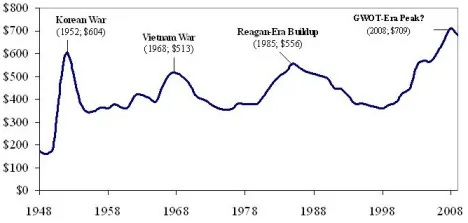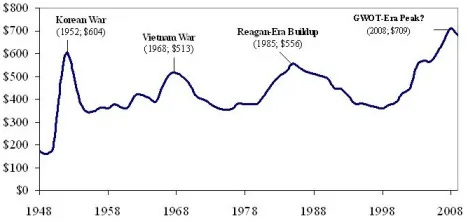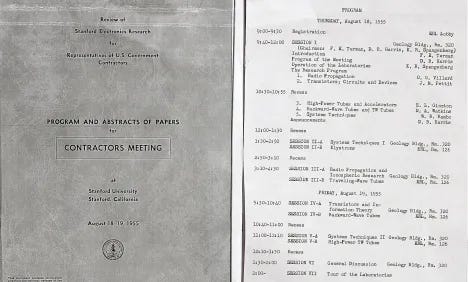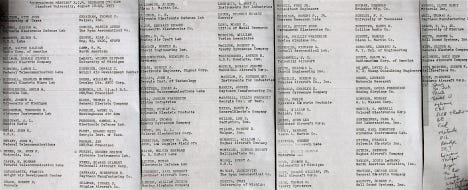This is Part X of “The Secret History of Silicon Valley.” Read Part I here, Part II here, Part III here, Part IVa here, Part IVb here, Part V here, Part VIa here, Part VIb here, Part VII here, Part VIII here and Part IX here. See the Secret History bibliography for sources and supplemental reading.
Swords Into Plowshares
After the end of World War II, returning veterans were happy to beat swords into plowshares (and microwave tubes) on the Stanford campus. From 1946 until 1950, Stanford’s Electronic Research Lab conducted basic research in microwave tubes. Although this research would lead to the development of the Backward Wave Oscillator and Traveling Wave Tube for military applications, Stanford was building tubes and circuits not entire systems. The labs basic research was done by graduate students or Ph.Ds doing postdoctoral internships, supervised by faculty members or hired staff (many from Fred Terman’s WWII Electronic Warfare lab.)
In 1949, with the detection of the first Soviet nuclear weapons test, the Iron Curtain falling across Europe and the fall of China to the Communists, Cold War paranoia drove the U.S. military to rearm and mobilize.
We’ll Do Great in the Next War
Early in 1950, just months before the outbreak of the Korean War the Office of Naval Research asked Fred Terman to build an Applied electronics program for electronic warfare. All branches of the military (the Air Force and Army would fund the program as well) wanted Stanford to build prototypes of electronic intelligence and electronic warfare systems that could be put into production by partners in industry. The Navy informs Terman that, “money was not a problem but time was.”
Pitching the idea to the President of Stanford, Terman enthusiastically said, “In the event of all-out war, Stanford would become one of the giant electronic research centers…” (A bit optimistic about the outcome perhaps, given that at this point both the U.S. and the Soviet Union had nuclear weapons.)
Crossing the Rubicon – The Applied Electronics Lab
Setting up a separate Applied Electronics Lab for military funded programs doubled the size of the electronics program at Stanford. The new Applied Electronics Laboratory was built with Navy money and a gift from Hewlett-Packard. With the memories of WWII only five years old, and the Cold War now a shooting war in Korea, there was very little discussion (or dissension) about turning a university into a center for the production of military intelligence and electronic warfare systems.
The work in the applied program focused in microwave and electronic fields in which faculty members or senior research associates specialized. Many of the other staff in the applied program were full-time employees hired to work solely on these military programs.
Electronic Intelligence (ELINT), Jammers and Over the Horizon Radar (OTHR)
The Applied Electronics Lab used the ideas and discoveries (on microwave tubes and receiver circuits) from Terman’s basic research program in the Electronic Research Lab. The Applied Lab would build prototypes of complete systems such as Electronic Intelligence systems, Electronic Warfare Jammers, and Over the Horizon Radar. The Applied Electronics Lab also continued work on the Klystron, pushing the tube to produce megawatts in transmitted power. (Stanford designed Klystrons producing 2½ Megawatts were manufactured by Varian and Litton would power the radar in the BMEWS (Ballistic Missile Early Warning System) built at the height of the cold war.) The close tie between the two labs was a unique aspect of the Stanford Lab. Stanford had a Customer Development loop going on inside their own lab. The discoveries in tube and circuit research suggested new electronic intelligence and countermeasure techniques and systems; in turn the needs of the Applied Lab pushed tube and circuit development. With the Applied Electronics Lab Stanford was becoming something akin to a federal or corporate lab run under university contract. The university found government contracts profitable as the government reimbursed their overhead charges (their indirect costs.) This means they could fund other non-military academic programs from this overhead.
The Stanford Applied Electronics Lab built prototypes which were handed off to the military labs for their evaluation. Subsequently military labs would contract with companies to build the devices in volume. In some cases, branches of the military contracted directly with Stanford which worked with local contractors in Silicon Valley to build these components or systems for the military. The prototype ELINT receivers built by the Applied Electronics Lab used the Stanford Traveling Wave Tubes. They quickly went into production at Sylvania Electronic Defense Labs down the street in Mountain View and Hallicrafters in Chicago. Later versions would be built by numerous industry contractors and installed on the fleet of ELINT planes orbiting the Soviet Union. These traveling wave tubes would also become the heart of the panoramic receiver used on the B-52 by the electronic warfare officer to get the bomber through the Soviet Air Defense system.
Jammers built by the Stanford Applied Electronics Lab used the Stanford Backward Wave Oscillators to produce high power microwaves. Unlike the simple noise jammers used in World War II, Soviet radars were becoming more sophisticated and newer designs were fairly immune to noise. Instead the jamming signal needed to be much smarter and have a deep understanding of how the targeted radar worked. Taking the information gleaned from our ELINT aircraft, Stanford built prototypes of jammers modulated with two new deception jamming techniques – angle jamming and range-gate pull-off. Some form of these deception jammers would eventually find their way into most electronic warfare defense systems used in the Cold War; first in the spy planes; the U-2, A-12 and SR-71. (Ironically the B-52 bomber, which would become the airborne leg of our nuclear triad, would use dumb noise jammers for two more decades – the Air Force opting to put the smart jammers on the B-58 and B-70, high altitude supersonic bombers – one soon obsolete and other never made it into production.)
The last major area of research that the Applied Electronics Lab group investigated was how radio signals propagated within the earth’s ionosphere. Over the next fifteen years this Radio Science Laboratory would receive the most funding of all departments in the lab (from the CIA) to build a ground based ELINT system. They would build and deploy two Over The Horizon Radar (OTHR) systems to detect Soviet and Chinese ballistic missile tests using ground based radars.
Guards at the Door – Stanford Joins the Cold War
In 1953 the Office of Naval Research told Terman that all military-funded projects (basic or applied, classified or not) needed to be in their own separate physical building. As a result Stanford moved the Applied work from the Electronics Research Lab into its own building.
In 1955, the pretense of keeping unclassified and classified work separate imposed too much of an administrative overhead and Stanford merged the Applied Electronics Lab and the Electronics Research Laboratory into the Systems Engineering Lab. The Applied Electronics portion of the lab was now the size of a small company. It had 100 people, 18 of them full time faculty, 33 research associates and assistants and 33 other tube technicians, draftsman, machinists, etc. Over half this lab would hold clearances for military secrets. (Top Secret: Terman, Harris, McGhie, Secret: 44 others, Confidential: 8 others. Terman, Harris and Rambo also had Atomic Energy Commission “Q” clearances.) Some students who were getting their engineering graduate degrees wrote masters and PhD thesis that were classified. Unless you had the proper clearances you couldn’t read them. Terman and Stanford had just made a major bet on the cold war, and Stanford ranked sixth among university defense contractors.
A security guard was stationed at the door of the Applied Electronics Lab to ensure that only those with proper security clearance could enter. The law of unintended consequences meant that this most casual addition in front of a university building would result in the occupation and destruction of the lab (and its twin at MIT) and the end of the program during the Vietnam War 14 years later. (More on this in a later post.)
Show and Tell – The Stanford ELINT and Electronic Warfare Contractors Meeting
During a typical year, the Applied Electronics Lab would host classified visits from military labs and defense contractors. By early 1950’s Stanford started holding a two day meeting for contractors and the military.
The 1955 attendee list gives you a feeling of the “who’s who” of the military/industrial establishment: RCA, GE, Motorola, AIL, Bendix, Convair, Mepar, Crosley, Westinghouse, McDonnell Aircraft, Douglas Aircraft, Boeing, Lockheed, Hughes Aircraft, North American, Bell Aircraft, Glen Martin, Ryan Aeronautics, Farnsworth, Sperry, Litton, Polarad, Hallicrafters, Varian, Emerson, Dumont, Maxson, Collins Radio. Other universities doing classified ELINT and Electronic Warfare work attended including University of Michigan, Georgia Institute of Technology and Cornell. Over a hundred government contractors reviewed Stanford’s work on microwave tubes and systems.
This was a classified conference at a university, the contractors not only got to hear the conference lectures, but also visited exhibits on the ELINT and electronic warfare devices and systems the lab had built. The lab would repeat the conference the following week for government agencies doing military work.
Barely noticed at the 1955 conference, a year before the first transistor company opened in Silicon Valley, one of the sessions described how to use a new device called a“transistor” to build wide-band amplifiers. (Terman had sent faculty and graduate students to the University of Illinois in 1953 to learn transistor physics.)
The World Turned Upside Down
The Applied Electronics Lab solidified Stanford’s lead as one of, if not the place in the U.S. military for advanced thinking in ELINT and Electronic Warfare. It would turn on its head the relationship of universities and corporations.
Traditionally universities chased corporations for funding and patronage, but the military’s dependence on Stanford’s and Fred Terman’s judgment turned that relationship on its head. Now the military was listening to Terman’s advice about which military contractors should get the order for to mass produce the Stanford systems. The contractors were now dependent on Stanford.
Terman the Rainmaker
During the 1950’s Fred Terman was an advisor to every major branch of the U.S. military. He was on the Army Signal Corps R&D Advisory Council, the Air Force Electronic Countermeasures Scientific Advisory board, a Trustee of the Institute of Defense Analysis, the Naval Research Advisory Committee, the Defense Science Board, and a consultant to the President’s Science Advisory Committee. His commercial activities had him on the board of directors of HP, Watkins-Johnson, Ampex, and Director and Vice Chairman of SRI. It’s amazing this guy ever slept. Terman was the ultimate networking machine for Stanford and its military contracts.
Stanford Industrial Park – Microwave Valley Booms
One part of Terman’s strategy was to use government funding to build Stanford’s engineering school and electronics program into a world-class program. However, he realized that building a connection to industry was equally important. (Turning Stanford into an outward facing university would be one of his singular accomplishments. In the 1950’s this was a radical idea.) Starting with Hewlett Packard and the microwave spinouts, Terman wanted a local industrial base tightly coupled with his Stanford engineering program.
By the early 1950’s many of the corporations that attended the yearly Stanford Electronic Warfare conferences would establish research labs centered around Stanford for just this reason – to learn from Stanford’s basic and applied research and get a piece of the ELINT and Electronic Warfare contracting pie.
Stanford Industrial Park was the first technology office park set up to house local and out of state microwave and electronics startups. First occupied in 1953 it would include Varian, Watkins Johnson, Admiral, HP, General Electric, Kodak, Lockheed. Other east coast companies which established branches in Microwave valley in the 1950’s included IBM, Sylvania, Philco, Zenith and ITT.
The Future is Clear – Microwave Valley Forever
By 1956 Fred Terman had every right to be pleased with what he had helped build in the last ten years in and around Stanford. The Stanford Electronics Lab was now the center of ELINT and Electronic Warfare.
Startups were sprouting all over Microwave Valley delivering microwave tubes and complete military systems, slowiy replacing the orchards and fruit trees. Granger Associates was a 1956 startup founded by Bill Ayer, a graduate student in the Applied Electronics Radioscience Lab, and John Granger, a former Harvard Radio Research Lab researcher, building ELINT and Electronic Warfare systems (the Granger jammer was carried on the U-2.) Four years later Ayer and another Granger engineer would leave Granger and found one of the preeminent electronic warfare and ELINT companies: Applied Technology.
The future of the valley was clear – microwaves.
1956 – Change Everything
Yet in 1956 two events would change everything. At the time neither appeared earthshaking or momentous. First, a Bell Labs researcher who had grown up in Palo Alto, had his own interesting World War II career, and recently served as a military advisor on cold war weapons systems, decided to follow Fred Terman’s advice to locate his semiconductor company near Stanford.
The second was when a Southern Californian aircraft company decided to break into the missiles and space field by partnering with Stanford electronics expertise. It moved its electronics research group from Burbank to the new Stanford Industrial Park and built its manufacturing facility in Sunnyvale.
Shockley Semiconductor Laboratory and Lockheed Missiles Systems Division would change everything.
Read about it in Part XI of the Secret History of Silicon Valley.






